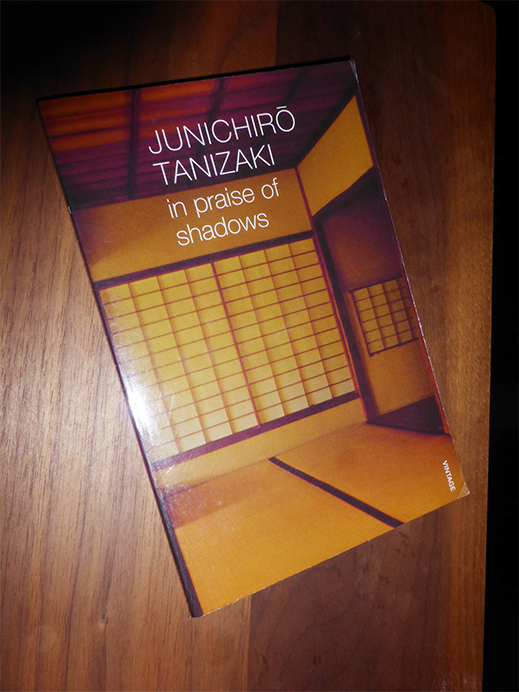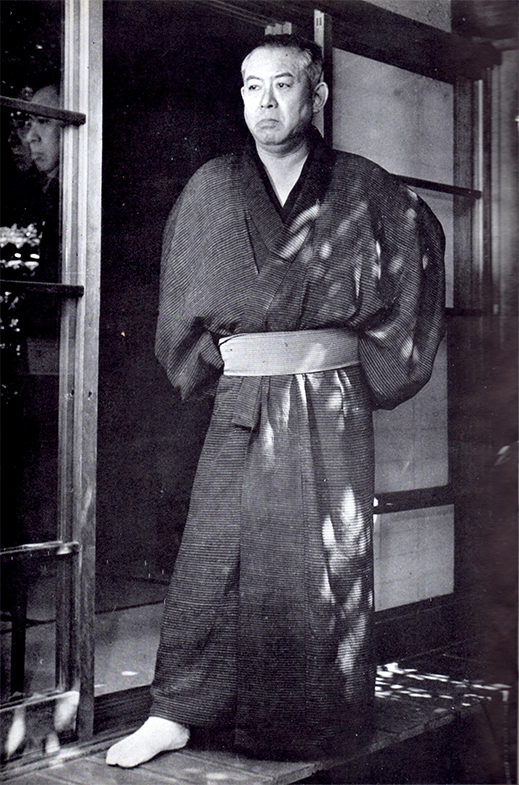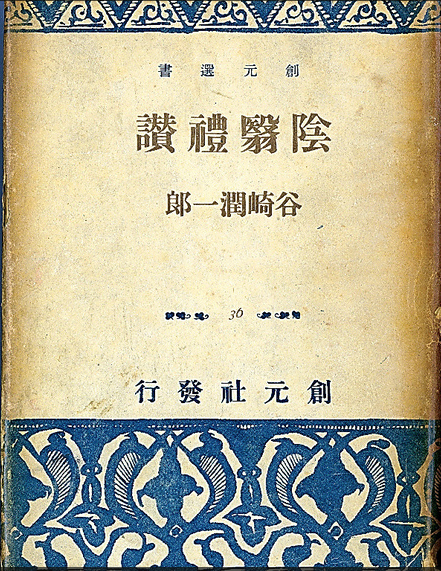 |
Focus features two in-depth reviews each month of fine art, architecture, and design exhibitions at art museums, galleries, and alternative spaces around Japan. |
|
|
 |
 |
 |
In Appreciation of Mindfulness: Revisiting Tanizaki’s Essay on Japanese Aesthetics
J.M. Hammond |
 |
Doors may be closed at museums across Japan, and around the world, but as art lovers spend more time indoors, this may also offer an opportunity for people to finally get to some of those art-related titles on their books-to-read list. An essential read is Jun'ichiro Tanizaki's In Praise of Shadows (In'ei Raisan), originally published in 1933-4. And for those already familiar with the essay, this may be a good time, nearly a century after its first appearance, to reconsider what it has to offer.
Tanizaki (1886-1965) is one of the most renowned authors of 20th-century Japan, alongside the likes of Yasunari Kawabata and Yukio Mishima. While some of his novels, such as The Key and Naomi, explore the territory of the erotic and the grotesque that was one hallmark of the Japanese modern (for example in the work of Edogawa Rampo), elsewhere Tanizaki laments the loss of traditional Japanese culture resulting from the rapid changes Japan was going through, as in his much-celebrated The Makioka Sisters (1956). A full two decades before that novel, Tanizaki explored the same idea in essay form in the pages of In Praise of Shadows.
|
 |
|
|
|
The first English translation of In Praise of Shadows, by Thomas J. Harper and Edward G. Seidensticker (Vintage, 2001; first published in 1977). Quotations in this review are from this translation. Photo by J.M. Hammond
|
Discerning a logical structure to the essay can be difficult, as Tanizaki presents his ideas in a non-linear fashion, seemingly in the order they come to him, sometimes returning to add another thought to a previously discussed topic.
Tanizaki opens the book musing on the difficulty of incorporating wires, cables, and pipes -- all emblematic of a modern Western-inspired lifestyle of convenience -- into a traditional Japanese house, without ruining the effect of the simplicity of Japanese architecture. It is a few dozen pages before he lays out his impression of what exactly he sees as the qualities of the Japanese house and what makes it different from those in the West -- and in the meantime his thoughts have run the gamut from the marvels of the outside toilet to different types of pens (brush or nib) and motion picture technology.
Once he gets going on architecture -- perhaps the most interesting topic he discusses in the book -- the author observes that the roofs of Japanese houses serve as a parasol, whereas those on Western houses are designed "less to keep off the sun than to keep off the wind and the dew."
What he views as a Japanese penchant for shadows is attributed to its people traditionally living under these heavy roofs of thatch or tile, and spending much of their lives in the "heavy darkness that hangs beneath the eaves." Tanizaki believes that the ancestors of today's Japanese, living this way, came to "discover beauty in shadows."
Tanizaki equates shadows with a sense of silence, suggesting that Japanese people intuitively feel that in the "darkness that gathers behind the crossbeams, around the flower vase, beneath the shelves . . . that here in the darkness immutable tranquility holds sway."
Shoji paper covering sliding doors and openings to the outside also plays a huge role in creating the atmosphere of the Japanese dwelling, diffusing the sunlight and creating deep pools of darkness in the furthest recesses of the rooms inside. Even in English translation, Tanizaki's evocative imagery comes through as he writes: "The
light from the garden steals in but dimly through paper paneled doors, and it is precisely this indirect light that makes for us the charm of a room."
|
 |
|
|
|
Jun'ichiro Tanizaki. Photo by Shigeru Tamura
|
In contrast, he sees the Western house, with its short peaked cap of a roof, as being designed to "allow the sunlight to penetrate directly beneath the eaves." He does not clearly single out (although the comparison is implicit) the glass windows of Western houses that, unless covered over by curtains or blinds, let in the sun's rays in all their harshness. More than anything else he reserves his wrath for the tyranny of electric lights, which also made their way into Japanese buildings during his lifetime.
These he despises for weakening the effect of the shadows in rooms and around objects, and for illuminating everything too brilliantly, destroying any sense of mystery. Indeed, among the more insightful of Tanizaki's observations is how the quality of light can determine how we perceive, and appreciate, objects around us. He describes how traditional lacquerware bowls (in black, red or brown) are often considered "vulgar and inelegant" in the modern age -- a perception he attributes to the overpowering brilliance of electric lighting. Tanizaki stresses that the richness of Japanese lacquerware comes alive when viewed in the dimness of candlelight. And if this is true for the deep black of a soup bowl, it is even more the case for items decorated in gold or silver.
Here, in his thoughts on the different qualities of light, Tanizaki unwittingly offers a tentative answer to one question that has long puzzled many observers of Japanese art and aesthetics -- how a culture renowned for its subdued and refined visual sensibility has also produced its seeming antithesis in objects that come uncomfortably close to being gaudy, or even step over that line. For Tanizaki there is no contradiction here, as a lacquerware bowl decorated with gold or silver, or a paper screen utilizing gold leaf, is made not with a view to being constantly visible under bright lights, but to be illuminated by candlelight or lamplight, glimpsed as it "gleams forth from out of the darkness . . ."
Considering all this celebration of shadows in the Japanese lifestyle, one might expect a strong exploration of light and shade to be a key feature of Japanese art. Yet this has not traditionally been the case, as it seems artists in Japan have long been more concerned with representing an object in its enduring aspect -- perhaps you could even go as far as to say the abstract idea of an object -- than its particular aspect under varying light conditions. Chinese-derived ink painting aside, there is little in traditional Japanese art, for all its brilliance of color and rendering of light, that shares the mysterious atmospheric effect of Leonardo da Vinci's sfumato technique, which softens harsh lines around objects, or the deep plunging shadows of Rembrandt or Caravaggio. In this sense, Tanizaki's focus on aesthetics generally, and the absence of enquiry into Japanese art, is notable. One wonders what Tanizaki would have to say about the shadow-free even lighting that characterizes much of Japanese painting.
|
 |
|
|
|
Cover of the 1939 edition of In'ei Raisan, published by Sogensha. Image used by permission of Sogensha
|
When comparing the Japanese sensibility favorably with that of the West, Tanizaki appears quite dismissive of Western culture and can come across as somewhat chauvinistic. Yet he also displays a down-to-earth acceptance that some form of change is inevitable in the modern era, admitting he cannot forsake such conveniences as electric lighting completely.
In Praise of Shadows may ramble somewhat, and leaves out much that could also be said, but it is not an exercise in logic -- more a poetic treatise and personal manifesto -- and, in a sense, it is as much about mindfulness and a sense of mystery as it is about shadows per se.
A few hours in the company of In Praise of Shadows, which takes up much less than one hundred pages, would be time well spent this spring. Just remember, don't read it under those garish electric lights; Mr. Tanizaki would not be impressed -- better to turn the pages by candlelight or bathed in the soft, warm glow of sunlight filtered through a paper screen.
 |
|
 |
 |
J.M. Hammond
J.M. Hammond researches modernity in Japanese art, photography and cinema, and teaches in Tokyo, including as a faculty lecturer in the English department at Meiji Gakuin University and at Gakushuin University. He has written about art for The Japan Times for over a decade. His essays include "A Sensitivity to Things: Mono No Aware in Late Spring and Equinox Flower" in Ozu International: Essays on the Global Influences of a Japanese Auteur (Bloomsbury, 2015) and "The Collapse of Memory: Tracing Reflexivity in the Work of Daido Moriyama" for The Reflexive Photographer (Museums Etc, 2013) [reprinted in the same publisher's 10 Must Reads: Contemporary Photography (2016)]. He has given various conference papers, including at the University of Hong Kong and the University of Oxford. |
|
 |
|